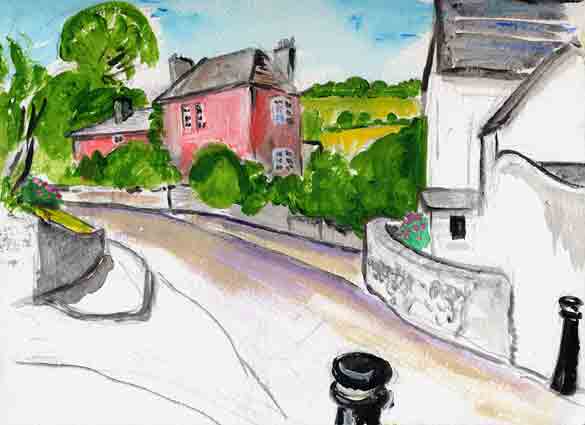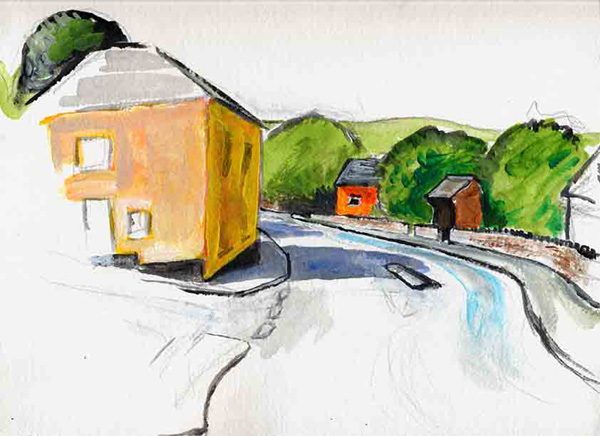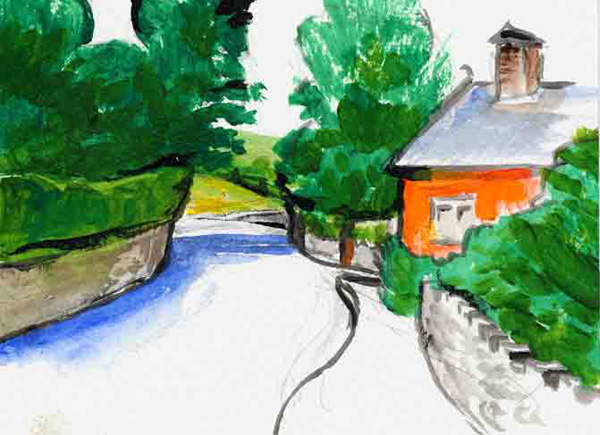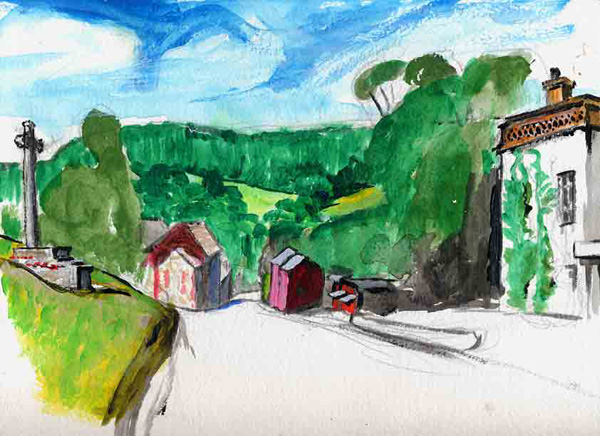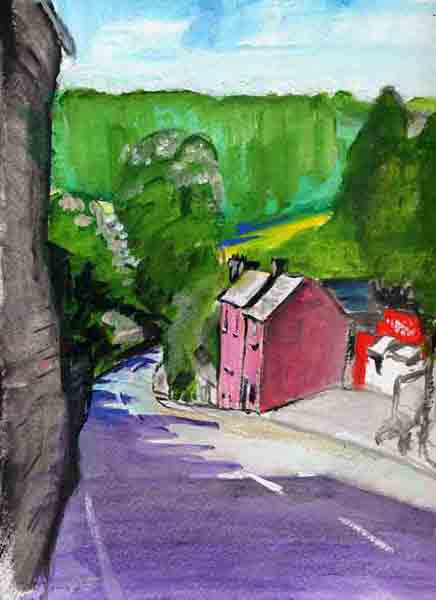The Lyme Maze Game

|
After just one house-length—that is, passing between one large rambling house close on the right and another on the left—and then a traffic-calming pinch point, this road that I'm calling the Silver Road gives a twist and throws off a steep turning down to the right, called Tapper's Knapp.
(There is also, on the left, something I took at first for a driveway—it has a gate that could shut it off—but it is called Trapper's Road (presumably copied from Tapper's Knapp) and leads up the hillside only to a few houses and Haydn White's garage. There is a curious perpetual gush of water from the embankment on the farther corner of Trapper's Road—it represents what is left of a stream coming down the side-valley.) Wrapping around the near right corner is a clump of cottages, of which one is still called the Toll House. There was a time when the northwestward route out of Lyme came to a toll gate at this point, then turned to the right, to plunge across the valley. You may do the same—swerve off around the Toll House and down Tapper's Knapp. Or keep on along the Silver Road, trying to remember that this—now lined with front gardens on the left, and a few older houses scattered on the right—was once a bridleway struggling through woods toward the sequestered hamlet of Uplyme. ==Stafford Mount There comes in sight the New Inn, now ==an insurance office. Beside it Whalley Lane branches uphill to the left.
And a little farther on, past a bus shelter, is Pound Cottage, recently painted an acute shade of orange. (But I'm in the minority that doesn't mind a touch of gaudy in the mild English scene.) It is on the corner of a lane whose name has been altered by a wag's brush from Crogg Lane to Grogg Lane.
The road squeezes through a narrow place between stone walls, where pedestrians have only a sort of small cowering-bay on one side. (Timid souls complain that it is dangerous; but it slows he the cars, because they can't see past it.) Beyond this constriction the road—which in the early twentieth century continued just as narrow, a country lane between hedges—now contrastingly opens out. On the left rises Barnes Meadow, a slope of head-high grass among which a short path pushes up to a pocket ledge on which stands Uplyme's war memorial. Or so the meadow looked when I first saw it, in 2001. Only a sinister little notice betrayed a "development approved". Local opposition could not stop but only ameliorate it, so now several tiers of cottages, expensive and sham but attractive after a fashion, look down over what is left of the meadow. Thus evaporated the last prominent open space between the coastal town of Lyme and the inland village of Uplyme.
Though the long-grass meadow is gone, the developers have made a setting for the memorial that is pleasant in its own tidier way, with a paved path that ends by spiralling down to it. Here on the Sunday nearest to Armistice Day in November, the villagers after the service walk from the church to lay their weaths to the dead of past wars—as is happening in every other village. On the other side of the road, opposite to Barnes Meadow, was until 2004 a butcher shop—one of only two shops remaining out of the fourteen this village once had. And next to that, a fine large house. It is still commonly called the Devon Hotel, but it has had several lives and harbours some spooky stories and even a secret tunnel—which, for all you know, could lead (for such is the nature of mazes) the way you want to go. Down ahead is the centre of Uplyme village. It looks more like the village's end: immediately beyond it can be seen wide open ground and then a forested hillside. Or you might be forgiven for thinking (as we did when we first came through looking for it) that there is no real Uplyme village: there has just been a nearly-continuous straggle from Lyme, ending here. Not so; there is a real and living village. The core of it is a small triangle, of which you see the lane called Venlake splitting left, and the main street dipping ahead.
The street is a short steep narrow canyon (even with a kind of cliff on the left: the rock platform under the first cottages in Venlake), and it is bombarded by traffic: the through traffic on the way to and from Lyme, and the traffic trying to park where there is hardly anywhere to park, so as to get to the village shop. Three cottages are jammed in after the shop; then comes the crossroads. Gore Lane is up to the left; the Silver Road runs on ahead past the Talbot Arms pub; and on the right, hard by the corner of the Talbot Arms, you could easily overshoot Church Street. It is narrow (has to be one-way), turns back acutely, and turns downward so sharply that the tarmac on the acute side of the angle descends at forty-five degrees. |
